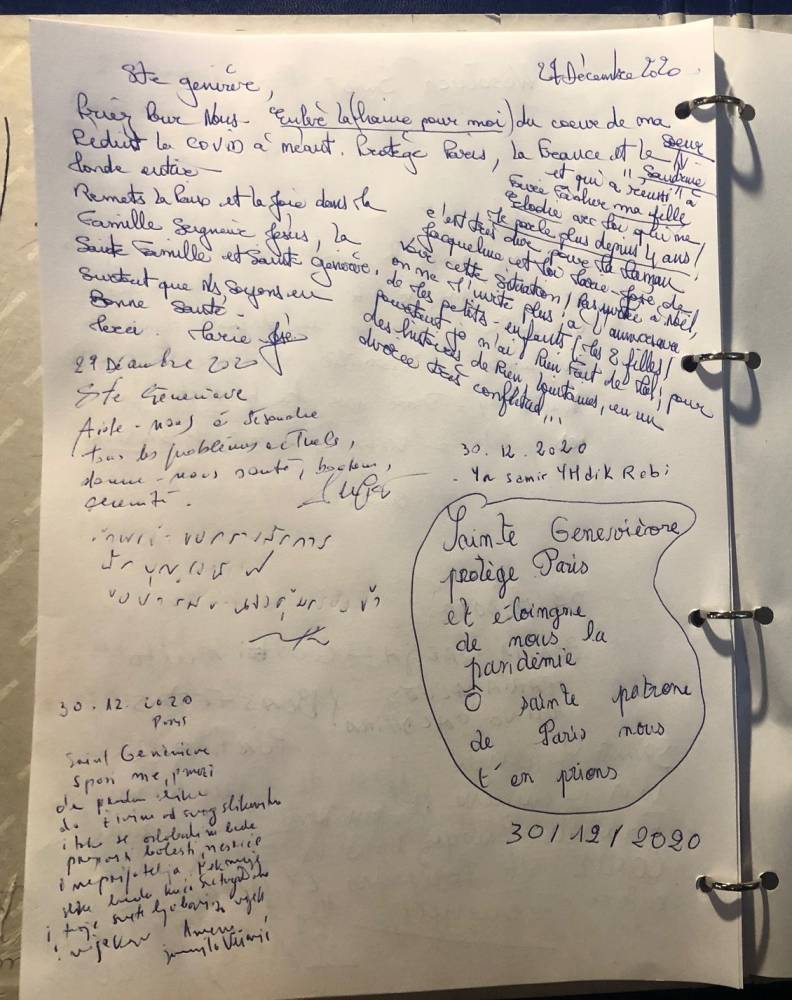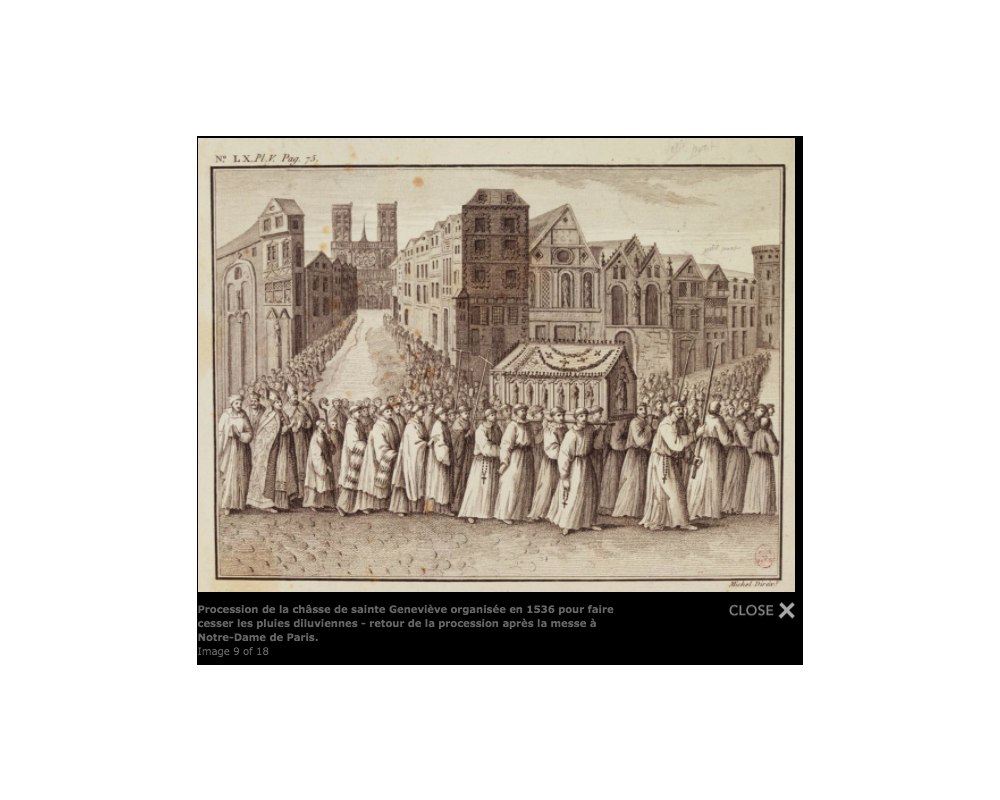As every year, on this date, the shrine containing the relics of the Patron Saint of Paris leaves the Saint-Étienne-du-Mont church to go to Notre-Dame, followed by a procession of several hundred faithful. This Sunday, January 10, it will not be the case, the fault of the confinement. Isn’t there a sort of paradox here since, since the Middle Ages, the processions of Saint Geneviève have been organized to protect Paris from public calamities and epidemics? Are the authorities not missing out on a golden opportunity to kick the Sars-CoV-2 virus out of Paris and even all of France?
–
So that Joan of Arc […] end the Covid.
The parish priest of Saint-Étienne-du-Mont told us that he will have to resolve to display the saint’s relics on the church square. Will it be enough? In any case, the faithful do not disarm by expressing their prayers on the guest book placed near the tomb of Geneviève: “Saint Geneviève, protect Paris and keep the pandemic away from us. O, patron saint of Paris, we beg of you. December 30, 2020. ”And again:“ Saint Geneviève, pray for us. Reduce the Covid to nothing. Protect the whole world. “And for good measure:” So that Joan of Arc and Saint Geneviève kick the Covid out of France. “For others, disease is not the only scourge threatening the country:” Saint Geneviève, save us from the Islamic invasion which threatens France. “

–
Protectress of Paris
Geneviève was born in 420 in Nanterre in a rich Gallo-Roman family and was baptized very young. France does not yet exist. The territory was then in the hands of the pagan Germanic peoples; Paris is under the domination of Clodion le Chevelu, king of the Salian Franks. From the age of 16, the young girl began an ascetic lifestyle, perfecting her virginity. Her family moved to Paris, where, soon, Geneviève succeeded her father as a member of the municipal council. She received the veil around 19 years old. A few years later, in 451, she acquired her reputation as the protector of Paris by encouraging the Parisians not to desert their city despite the advance of the Huns led by Attila. His words have been reported to us: “Let men flee, if they want, if they are no longer able to fight. We women will pray to God as much and as long as he hears our pleas. “
At the last moment, indeed, Attila turns away from Paris. Should we believe in divine intervention? Rather, historians tend to think that the barbarian ruler considered it more interesting to wage war on the Visigoths of Aquitaine rather than take a modest city. Anyway, the good people of Paris make Geneviève accountable for this miracle and make her their protector. In 886, when Paris was on the verge of succumbing to the sixth siege of the Vikings, the defenders then remember the miracle operated four centuries before by Geneviève. They bring his relics at the height of the fighting, as well as those of Saint Germain. Rejuvenated by this visit, the Parisians redouble their ardor and push back the invaders.
Plague epidemics
From then on, the reputation of the saint is made. As soon as a great misfortune threatens the capital of France, it is put to work by organizing an exceptional procession of its relics. Between 885 and 1947, there are 95. Let us quote that of November 26, 1130 to put an end to the terrible burning disease which killed 14,000 people. This is rye ergot poisoning (mold). The chronicle affirms that, of the 103 patients who touched the reliquary during its journey, 100 recovered. Not the other three, who were skeptics.

-In 1239, Saint Louis appealed to the saint for the healing of his bedridden brother, the Count d’Artois. The instant the reliquary crosses the doors of the Sainte-Geneviève abbey, where it is kept, the count heals instantly. On several occasions, the saint resumed service to protect the city, whether from torrential rains, floods or droughts. And to fight against global warming? Who knows ?
Geneviève is also called upon to stop epidemics, including the plague. In 1481, she postponed the death of Louis XI for two years. In May 1521, she put an end to a famine by bringing in five wheat boats. It is invoked on several occasions to promote peace or the victory of the French armies. On the other hand, she fails to save Henry II from death after his horrific injury during a tournament. She is also asked to fight against heresy and the preservation of the Catholic religion.
Ashes thrown into the Seine
Then comes the Revolution. Despite her strong celestial support, Saint Geneviève did not escape the wrath of the sans-culottes. Its reliquary and its contents were burned in Place de Grève and its ashes, thrown into the Seine, on December 3, 1793. Some bone fragments which had previously been offered to Notre-Dame and to the abbey of Chelles were subsequently recovered, placed in shrines and installed in the church of Saint-Étienne-du-Mont. This allowed the resumption of the processions. On September 8, 1914, Saint Geneviève was again called upon to protect Paris from German troops. And it works since, four days later, the Battle of the Marne put an end to the Teutonic advance. We wanted to do it again on May 19, 1940 to stop the Wehrmacht, but this time the saint was probably with absent subscribers since Paris fell into the hands of the Nazis. But the refusal, four years later, of General Dietrich von Choltitz to destroy Paris is perhaps to be credited to him.
Therefore, no more extraordinary procession from the shrine of Saint Geneviève. From 2007, the processions are scheduled again, but on an annual basis, around the date of the saint’s birth. It is no longer a question of a reference to a specific public calamity, but of a simple expression of devotion. This year, it will be necessary to be satisfied with an exhibition. The novena of prayers which has just ended was dedicated to the healthcare staff who worked during the pandemic.
–


